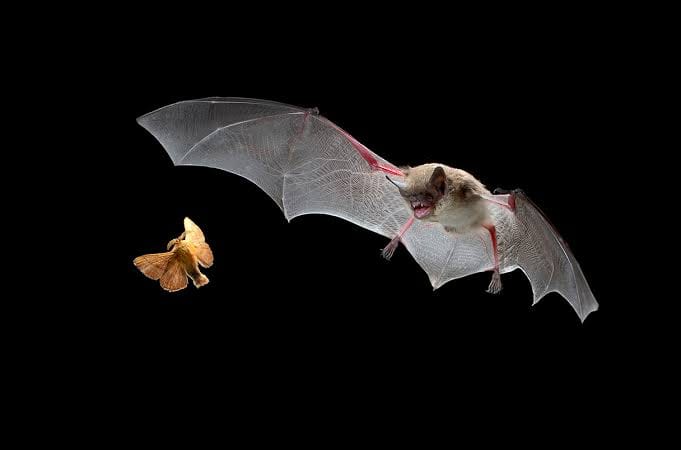As the sun sinks below the horizon and daylight gives way to the deepening shadows of dusk, a silent transformation overtakes the natural world. Day-active creatures retreat into shelter while the night awakens with a new set of players. Among them, bats emerge—enigmatic, elusive, and supremely adapted for life in the darkness. Flitting through the night air with astonishing agility, these aerial mammals seem to defy the very laws of navigation. They evade branches, detect fluttering insects, and even engage in complex social behaviors—all without the benefit of vision. How is it possible?
The answer lies in one of the most remarkable biological systems in the animal kingdom: echolocation. This evolutionary innovation has elevated bats to master hunters of the night, allowing them to “see” with sound in total darkness. But echolocation is far more than just a substitute for sight—it is a high-resolution, multi-dimensional, active sensing system that rivals some of the most sophisticated human technologies. It is the biological equivalent of radar and sonar, yet vastly more nuanced, and capable of remarkable feats of perception.
To understand how bats navigate and hunt using echolocation, we must venture into a world where sound replaces sight, where milliseconds matter, and where evolution has crafted extraordinary adaptations for life in the dark.
Beyond Vision: The Origins of Acoustic Hunting
The fossil record indicates that bats have been around for more than 50 million years, making them one of the oldest groups of flying mammals. Echolocation likely evolved early in their evolutionary history, possibly even before the development of powered flight. This acoustic adaptation gave early bats a decisive advantage over their competitors, opening up a nocturnal ecological niche rich in untapped resources.
Echolocation allowed bats to exploit a world teeming with nocturnal insects—moths, beetles, mosquitoes, and more. While birds ruled the skies by day, bats colonized the night, becoming some of the most abundant and diverse mammals on the planet. With more than 1,400 species worldwide, bats now represent around 20% of all known mammal species.
This incredible diversity is matched by a wide range of echolocation strategies. Some bats emit high-frequency calls through their mouths; others use their nostrils. Some produce broadband, frequency-modulated signals that sweep across a range of pitches, while others use constant-frequency calls that stay at a single tone. These variations are not arbitrary—they reflect specialized hunting tactics, environmental constraints, and prey behavior.
Painting the World with Sound
At the heart of echolocation lies the ability to emit high-frequency sound waves and interpret the returning echoes. When a bat flies through the air, it emits a series of ultrasonic calls—sounds too high-pitched for human ears to detect. These calls travel through the air, bounce off nearby objects, and return as echoes. By analyzing the time delay, pitch shift, and intensity of these returning signals, the bat can construct a detailed acoustic map of its surroundings.
This process happens at astonishing speed and with extraordinary precision. Bats can distinguish objects less than a millimeter apart. They can detect the fluttering wings of a mosquito from several meters away. They can even determine the texture, shape, and movement of prey—all from the subtle patterns in the returning sound waves.
The emitted calls are typically in the range of 20 to 200 kilohertz (kHz), well above the upper limit of human hearing, which is around 20 kHz. These ultrasonic frequencies provide better spatial resolution because shorter wavelengths can resolve smaller objects. But there’s a trade-off: high-frequency sound attenuates quickly in air, limiting the range. To overcome this, bats have evolved highly directional calls and specialized anatomy to focus and amplify their signals.
A Symphony of Signals: Echolocation Call Types
Not all echolocation is created equal. Different bat species use distinct call types that are finely tuned to their ecological niches. Two major categories dominate: frequency-modulated (FM) calls and constant-frequency (CF) calls.
FM calls sweep rapidly through a range of frequencies and provide excellent spatial resolution. These are ideal for identifying the location and shape of nearby objects, making them particularly useful in cluttered environments like forests. Bats that hunt near vegetation or in caves—such as those from the family Vespertilionidae—tend to rely on FM calls.
CF calls, on the other hand, maintain a stable frequency over time. They are especially effective at detecting movement through a phenomenon known as the Doppler shift. When prey moves toward or away from the bat, the frequency of the returning echo changes slightly. Bats with CF calls can detect these shifts with extraordinary accuracy, allowing them to zero in on fast-moving targets like flying insects.
Some species combine both types of calls in what are known as CF-FM calls. These hybrid signals offer the best of both worlds—detecting motion with CF and pinpointing location with FM. This strategy is particularly effective in open spaces where bats need to locate fast, erratic prey over longer distances.
The Neurobiology of Sound Perception
Processing echolocation signals requires an immense amount of neural computation. A bat’s brain must analyze incoming echoes in real time, distinguishing between its own vocalizations and ambient noise, calculating distances, identifying targets, and adjusting flight paths—all in fractions of a second.
At the core of this process is the auditory cortex, where sound is interpreted and transformed into spatial information. Bats have evolved specialized brain structures that are tuned to the frequencies they emit. For example, in CF bats like the greater horseshoe bat (Rhinolophus ferrumequinum), certain regions of the auditory cortex are dedicated to analyzing Doppler shifts, giving them exquisite sensitivity to motion.
But echolocation is not purely auditory. It is deeply integrated with motor control and spatial memory. As bats fly, their brains constantly update an internal map of the environment, comparing new echoes with previous ones. This feedback loop allows them to anticipate obstacles, track prey, and coordinate group movements with other bats.
Moreover, bats can adjust their calls dynamically. They increase call rates when approaching prey, narrow the beam of their calls for greater precision, and even alter the frequency to avoid interference from other bats or environmental noise. This ability to modulate echolocation signals in response to changing conditions is known as “active sensing”—a hallmark of intelligent behavior.
Hunting in Cluttered Spaces
One of the greatest challenges in echolocation is distinguishing targets from background clutter. Forests, caves, and urban environments are filled with acoustic obstacles that reflect sound—branches, leaves, walls, and other animals. For a bat hunting in such environments, the echoes can become a jumbled mess.
To cope, many bats use broadband FM calls that provide high spatial resolution. These allow them to separate closely spaced objects based on the time delay and spectral differences in the returning echoes. Some bats emit calls in rapid succession—a behavior called “sonar strobe groups”—to get multiple updates on target movement.
Others, like the gleaning bats, adopt a different strategy altogether. Instead of catching prey in mid-air, they listen for the rustling sounds of insects on leaves or the ground. These bats have large ears and highly sensitive hearing, allowing them to detect faint noises and remain almost silent while hunting. Their echolocation calls are often whisper-quiet, minimizing acoustic clutter and helping them avoid detection by prey.
Defeating Countermeasures: The Evolutionary Arms Race
No evolutionary advantage goes unchallenged, and echolocation is no exception. Over millions of years, some insect species have developed countermeasures to avoid being caught by echolocating predators. Moths, in particular, have evolved an impressive suite of defenses.
Some moths possess ears tuned to bat echolocation frequencies. When they detect an approaching bat, they may take evasive action—diving, spiraling, or dropping suddenly to escape detection. Others have evolved sonar-jamming abilities. Certain tiger moths, for example, produce their own ultrasonic clicks that interfere with a bat’s echolocation, confusing it and preventing accurate targeting.
In response, bats have become more cunning. Some reduce the intensity of their calls as they close in on prey, switching to low-amplitude “stealth mode” to avoid alerting moths. Others have diversified their call structures, using variable frequencies to outmaneuver moth defenses.
This evolutionary arms race has led to astonishing behavioral sophistication. Bats are not just passive receivers of sound—they are intelligent hunters capable of strategy, adaptation, and decision-making in complex acoustic environments.
Echolocation and Social Communication
While echolocation is primarily a tool for hunting and navigation, it also plays a role in social behavior. Bats live in colonies ranging from a few individuals to millions, and coordinating movement in such groups requires communication.
Many species use modified echolocation calls or separate vocalizations to identify group members, signal aggression, or attract mates. These vocalizations can convey identity, emotional state, and reproductive status. In some cases, bats engage in vocal learning, acquiring dialects unique to their social group—an ability once thought to be limited to birds and humans.
Recent research suggests that some bats may even engage in vocal turn-taking and rudimentary forms of conversation. This blurs the line between sensory perception and social communication, highlighting the complex cognitive abilities of these nocturnal mammals.
Bats Versus Humans: Comparing Biological and Artificial Sonar
Humans have long sought to emulate the abilities of echolocating animals. Sonar and radar systems—used in submarines, aircraft, and autonomous vehicles—are direct technological analogs of bat echolocation. These systems emit sound or radio waves and measure the returning signals to construct images of the environment.
Yet even the most advanced artificial systems fall short of the flexibility, resolution, and real-time processing found in bats. Modern sonar lacks the dynamic call modulation, contextual interpretation, and energy efficiency of biological echolocation. Bats accomplish in milliseconds what computers struggle to do in real-time.
This has inspired a new wave of research in bio-inspired engineering. Scientists are studying bat sonar to develop better robotics, drones, and navigation systems for use in complex environments. Some engineers are even experimenting with miniature sonar devices modeled after bat anatomy, aiming to create tools for the visually impaired that mimic echolocation.
The Future of Echolocation Research
Despite decades of study, echolocation remains a frontier of scientific discovery. Emerging technologies—such as high-speed infrared videography, miniature neural implants, and 3D acoustic modeling—are revealing new layers of complexity in how bats use sound to perceive the world.
Researchers are now exploring how echolocation integrates with other senses, such as vision and smell, to produce a holistic picture of the environment. They are investigating the genetics of echolocation, identifying genes involved in hearing, vocalization, and neural processing. They are also studying how echolocation develops in juvenile bats, offering clues about learning, plasticity, and evolution.
These discoveries not only deepen our understanding of bats, but they also illuminate fundamental principles of perception, cognition, and communication in all animals—including humans.
Echoes of Wonder
Bats challenge our assumptions about the senses. They invite us to imagine a world constructed not from light and color, but from sound and time. They show us that nature’s solutions to life’s challenges are often more elegant and efficient than our own.
When we watch a bat darting through the night sky, zigzagging with impossible precision, we are witnessing an evolutionary marvel. We are seeing a creature that has mastered the art of perception in darkness—a creature whose mind is shaped by sound in ways we are only beginning to comprehend.
To study bats is to be humbled, inspired, and filled with awe. In their echoes, we find not only the secrets of night hunting, but a deeper understanding of how the brain, the body, and the environment interact to produce consciousness. Theirs is a silent symphony—a hidden world pulsing with meaning and intelligence.
As science continues to listen more closely to these echoes, we may yet uncover new ways to perceive, communicate, and navigate our own lives. Until then, the bats will continue their nightly flights, weaving invisible maps in the sky, their voices painting the dark with sound.






